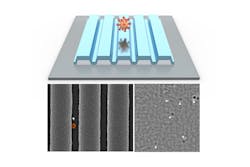Microscopy technique could be powerhouse for rapid diagnostics
Researchers at the University of Illinois Urbana-Champaign (Champaign, IL) have developed a fast, low-cost microscopy technique to see and count viruses or proteins from a sample in real time, without any chemicals or dyes. Called photonic resonator interferometric scattering microscopy (PRISM), the technique could lead to devices for rapid diagnostics and viral load monitoring, including HIV and the virus that causes COVID-19.
In optical microscopes, light bounces off any molecules or viruses it encounters on a slide, creating a signal. Instead of a regular glass slide, the PRISM technique uses photonic crystal—a nanostructured glass surface that brilliantly reflects only one wavelength of light. The research team, led by Brian Cunningham, the Intel Alumni Endowed Chair of electrical and computer engineering and a member of the Holonyak Micro and Nanotechnology Lab and the Carl R. Woese Institute for Genomic Biology, designed and fabricated a photonic crystal that reflects red light, so that the light from a red laser would be amplified.
Because the molecules under observation (viruses and small proteins) in the research team’s study are extremely small, they cannot scatter enough light to create a signal that can be detected by a conventional optical microscope, explains graduate student Nantao Li, the first author of the paper that describes the work. Using a photonic crystal amplifies the light’s intensity to simplify detection of those signals, enabling the team to study these proteins and viruses without any chemical labels or dyes that might modify their natural state or hinder their activity. Therefore, Li says, the team can just use the intrinsic scattering signal as the gauge for determining if those molecules are present.
The researchers verified their technique by detecting the SARS-CoV-2 virus, which is the virus that causes COVID-19. PRISM detected individual coronaviruses as they traveled across the slide’s surface. The researchers also used PRISM to detect individual proteins such as ferritin and fibrinogen. The technique could allow researchers to study such biological targets in their natural states (such as watching as proteins interact) or to seed the surface of the photonic crystal slide with antibodies or other molecules to capture the targeted items and hold them in place.“It takes 10 seconds to get a measurement, and in that time we can count the number of viruses captured on the sensor,” Cunningham says. “It’s a single-step detection method that works at room temperature. It is also fast, very sensitive, and low cost. It’s very different from the standard way we do viral testing now, which involves breaking open the viruses, extracting their genetic material, and putting it through a chemical amplification process so we can detect it. That method, called PCR, is accurate and sensitive, but it requires time, specialized equipment, and trained technicians.”
Cunningham’s group is working to incorporate PRISM technology into portable, rapid diagnostic devices for COVID-19 and HIV viral load monitoring. The group is exploring prototype devices that incorporate filters for blood samples and even condensation chambers for breath tests.
“We are also going to use this as a research tool for biology and cancer,” Cunningham said. “We can use it to understand protein interactions that are parts of disease processes. We are interested in using it to detect these tiny vesicles that cancer cells shed, and to see what tissues they come from, for diagnosis, and also to study what cargo they are transporting from the cancer cells.”
Full details of the work appear in the journal Nature Communications.

